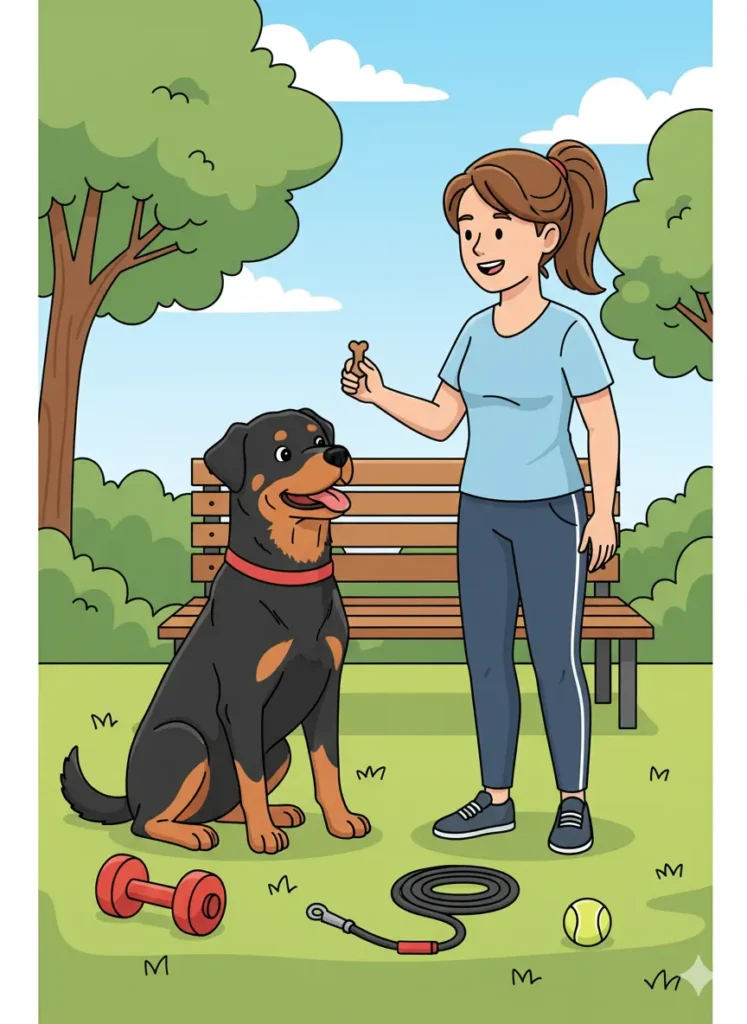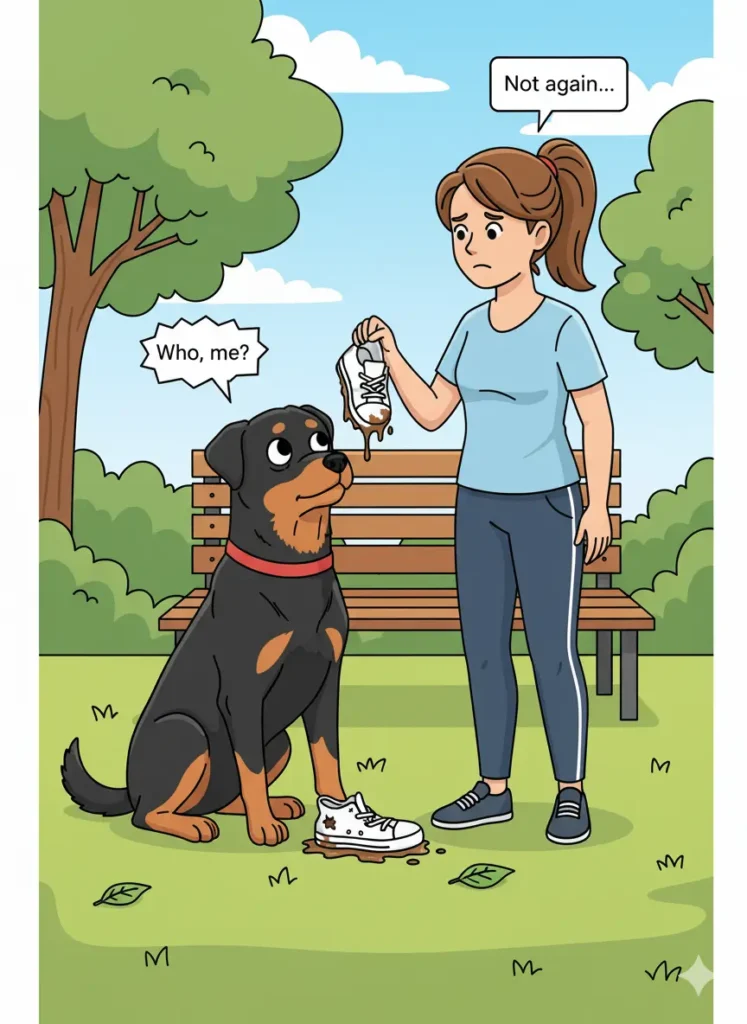Thinking about getting a German Rottweiler? Or maybe you already have one, and you’ve realized this dog is a mix of strength, loyalty, and stubbornness all wrapped in a heavy, affectionate package.
Caring for a Rottweiler isn’t simple. They’re smart, powerful, and need steady guidance every day.
They’ll test your patience, challenge your consistency, and still manage to win you over when they decide to curl up beside you like a 100-pound puppy.
Here’s what it really takes to raise, feed, and train a German Rottweiler, along with a few real-life challenges most people don’t talk about when they share those cute Rottie puppy photos online.
Getting to Know Your German Rottweiler
Before we jump into the diet and training tips, let’s talk about what makes this breed so special.
The Personality Package
German Rottweilers are the classic definition of loyal protectors. They’re calm, confident, and naturally suspicious of strangers. But don’t mistake that for aggression they just take their “family security guard” job very seriously.
Once they trust you, though? You’re their person for life.
They’ll follow you from room to room, guard your house like it’s Fort Knox, and look at you with those big, soulful eyes that say, “I love you, but I’m still watching that mailman.”
Physical Traits
- Weight: Males usually weigh around 95–135 pounds, females between 80 and 100 pounds
- Height: About 22–27 inches tall at the shoulder
- Coat: Short, double-coated, black with rust or mahogany markings
- Build: Broad, muscular, and slightly intimidating (okay, very intimidating)
These dogs were bred in Germany for herding and guarding, so that instinct to protect and control runs deep. And if you’ve ever seen a Rottie try to “herd” kids or cats in the yard, you know exactly what I mean.
Feeding a German Rottweiler: Diet Tips That Actually Work

Let’s talk about food the magic word in every Rottie’s vocabulary.
These dogs love to eat. And I mean love. But that also means they can gain weight fast if you’re not careful.
What to Feed
A balanced high-protein diet is key. Look for dog food with:
- Real meat (chicken, beef, lamb, or fish) listed as the first ingredient
- Moderate fat content for energy and coat health
- Glucosamine and chondroitin for joint support (Rotties are prone to hip and elbow issues)
- Omega-3 fatty acids for a shiny coat and healthy skin
How Much to Feed
Here’s the tricky part Rotties don’t all burn calories the same way. A working or highly active dog needs more food than a couch potato.
General rule:
- Adult males: 4–6 cups of high-quality dry food daily (split into two meals)
- Adult females: 3–5 cups daily (also split)
Avoid free-feeding (leaving food out all day). Your Rottie will absolutely overeat.
Foods to Avoid
Just because your Rottie gives you that “please, just one bite” face doesn’t mean you should cave. Avoid:
- Chocolate (obviously)
- Onions and garlic
- Cooked bones (they splinter)
- Fatty table scraps
- Grapes and raisins (toxic!)
And FYI, these dogs have sensitive stomachs. So if you switch their food, do it gradually or prepare to deal with some serious tummy drama. :/
Training Your German Rottweiler Like a Pro

Here’s where things get interesting.
Training a German Rottweiler is not about being the “alpha” or showing dominance (that’s outdated nonsense). It’s about earning their respect through consistency, confidence, and fairness.
Start Early
The sooner you start training, the better. Rottie puppies are adorable little furballs until they realize they’re stronger than you.
Begin with basic commands like:
- Sit
- Stay
- Come
- Leave it
Use positive reinforcement — treats, praise, and playtime. They respond better when they’re rewarded, not scolded.
Socialization Matters (A Lot)
Ever met a Rottweiler that’s aggressive toward strangers or other dogs? That’s usually a socialization problem, not a breed problem.
Expose your Rottie puppy to:
- Different people (men, women, kids, mail carriers, etc.)
- Other dogs and animals
- New environments (parks, vet offices, noisy streets)
A well-socialized Rottweiler is calm, confident, and far less likely to develop behavioral issues later.
Mental Stimulation
Rottweilers are smart — too smart sometimes. If you don’t keep their brains busy, they’ll find ways to entertain themselves (like chewing your couch cushions).
Try:
- Puzzle toys
- Scent games (hide treats and let them find them)
- Obedience classes
- Agility training
Basically, keep their minds as active as their muscles.
Exercise Needs: Burn That Energy (Before It Burns You)
Ever seen a bored Rottweiler? It’s like watching a toddler with super strength. Not fun.
These dogs need at least 60 minutes of daily exercise — a mix of walking, running, and structured play.
Best Exercises for German Rottweilers
- Long walks or hikes (they love exploring)
- Fetch or tug-of-war sessions
- Swimming (great for joints)
- Obedience or agility games
If you don’t have time for daily exercise, this might not be the breed for you. A tired Rottweiler is a happy Rottweiler — and a lazy one won’t destroy your furniture. Win-win.
Common Health Issues and How to Handle Them
German Rottweilers are generally strong, but they do have a few breed-specific health risks you should watch out for.
Most Common Problems:
- Hip and elbow dysplasia (painful joint conditions)
- Heart problems (like aortic stenosis)
- Bloat (a dangerous stomach condition)
- Cancer (especially bone cancer)
- Allergies and skin problems
How to Keep Them Healthy
- Schedule regular vet checkups
- Feed a balanced diet
- Keep their weight in check (extra pounds = joint stress)
- Add joint supplements if your vet recommends them
- Brush their coat weekly to reduce shedding
Oh, and here’s something most new Rottie owners don’t realize: this breed hides pain well. So if your dog suddenly stops jumping or seems off, don’t ignore it. Rottweilers are tough — sometimes too tough for their own good.
Real-Life Challenges of Owning a German Rottweiler

Let’s get real for a second. Owning a German Rottweiler is amazing, but it’s not all tail wags and loyalty montages.
Challenge #1: They’re Strong. Like, Really Strong.
If your Rottie decides to chase a squirrel mid-walk, you’re going with them. These dogs are muscular and powerful — leash training is not optional.
Challenge #2: They Need Constant Mental Stimulation
A bored Rottweiler is a destructive Rottweiler. You’ll come home to chewed shoes, shredded cushions, and a dog that looks at you like, “What? You left me with nothing to do.”
Challenge #3: People Judge Them
Sadly, Rottweilers get a bad rap thanks to irresponsible owners. Expect some people to cross the street when you’re walking your dog.
It’s your job to show the world how well-trained, gentle, and loving these dogs can be.
Challenge #4: Separation Anxiety Is Real
Rotties get attached deeply. Leaving them alone for long hours can cause anxiety and destructive behavior. They need your time and presence, not just your backyard.
Challenge #5: Grooming Isn’t “Low Maintenance”
Sure, their coats are short, but they shed more than you’d expect. Regular brushing and occasional baths will save your house from looking like a fur tornado hit it.
The Rewards: Why It’s All Worth It
Now, after all that, you might be wondering, “Is a German Rottweiler really worth the effort?”
IMO? Absolutely.
They’re fiercely loyal, endlessly loving, and always ready to protect you. Once you earn their trust, you’ll have a best friend for life.
They’re also surprisingly gentle with kids (when trained properly) and incredibly smart. And that goofy side they show when they think no one’s watching? Yeah, that’s the stuff that makes every challenge worth it. 🙂
Quick Care Checklist
Before we wrap up, here’s your German Rottweiler care cheat sheet:
Daily Needs:
- 60+ minutes of exercise
- 2 meals of high-protein dog food
- Playtime or training sessions for mental stimulation
Weekly Needs:
- Brushing to control shedding
- Basic obedience refresher
- Social interaction (walks, parks, guests)
Monthly or As Needed:
- Vet checkups
- Nail trimming and ear cleaning
- Flea/tick prevention
Keep this list handy; your Rottie will thank you with wagging tails and slobbery kisses.
Conclusion
Owning a German Rottweiler is both a challenge and a privilege. They’ll test your patience, make you laugh, and occasionally drag you across the yard, but they’ll also guard your home, comfort you when you’re sad, and love you unconditionally.
If you’re ready to put in the time, energy, and heart this breed deserves, the payoff is unmatched. You don’t just get a dog; you get a loyal companion, a fearless protector, and a best friend rolled into one giant, drooling, lovable package.
So go ahead, give your Rottie a pat on the head (and maybe a treat). They’ve earned it, and so have you.
